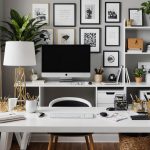Ideal Layout for a Home Office
The layout design for a podcast home office can significantly impact productivity. A dedicated podcasting workspace ensures that distractions are minimized and creative flow is maintained. Choosing the right room size is crucial. An adequately sized space allows for essential equipment and furniture without feeling cramped.
When arranging furniture, consider practicality. A sturdy desk is a must, providing a central point for recording and editing. Position your chair and microphone for comfortable, extended use. Storage solutions should keep cables and equipment organized and accessible.
This might interest you : Designing your serene screen-free family retreat: a comprehensive guide for modern homes in the digital age
Creating distinct zones within your home office caters to different needs. A recording zone with soundproofing elements will enhance audio quality. Your editing zone should facilitate focus, perhaps with ergonomic seating and a dual-monitor setup. Don’t neglect a relaxing zone; integrating comfortable seating for breaks can recharge your creativity and productivity.
Remember to incorporate personal preferences in your layout design. Consider recent trends like standing desks or customizable lighting to enhance your workspace. By meticulously planning the layout design for your podcast home office, you create a space that is not only functional but inspiring. This approach allows for efficient workflow and nurtures creativity.
Also to see : Revamp your home office: stylish and clutter-free ways to personalize your workspace
Essential Equipment and Technology
Selecting podcasting equipment essentials is crucial for both novice and experienced podcasters. For beginners, a basic setup might include a USB microphone and a pair of headphones. For professionals, more advanced options like XLR microphones paired with an interface can offer superior sound quality. Investing in quality microphones ensures clear audio, minimizing background noise, and giving a polished, professional sound to recordings.
Along with microphones, a good set of headphones is vital. They assist in monitoring audio levels and help identify background noise during recording sessions. Closed-back headphones are often recommended for podcasting due to their ability to block external sound.
To further enhance your podcast, consider investing in software and tools. Digital Audio Workstations (DAWs) such as Audacity or Adobe Audition provide robust features for editing and sound mixing. Many podcasters find value in using software with noise reduction, EQ, and effects to refine their sound further.
While high-end equipment can enhance the quality of your podcast, starting with basic, reliable tools and gradually upgrading as your skills and audience expand is a practical approach. Prioritizing strategic investments helps optimize recording sessions and ensures a smoother production process.
Acoustics and Soundproofing Techniques
Improving acoustics for podcasting starts with grasping sound engineering fundamentals. Understanding how sound waves behave can significantly enhance your podcast’s audio quality. This involves managing sound reflections and echoes, crucial elements in creating clear recordings.
When contemplating soundproofing, selecting effective materials is key. Home offices benefit from products like acoustic panels, which absorb sound efficiently. Dense materials such as mass-loaded vinyl can also block external noise, providing a quieter environment. Incorporating these into your workspace can drastically reduce unwanted background sounds.
Furnishings offer a creative approach to acoustics for podcasting. Strategically placing items like bookshelves or curtains can mitigate sound disturbances and reverberations. Soft furnishings, such as rugs and drapes, are particularly effective in absorbing sound and preventing it from bouncing around your office.
Lastly, experimenting with the layout and composition of your workspace can optimize acoustics. Move your furniture to disrupt sound paths, ensuring that your recording environment is as conducive as possible. Advanced knowledge of acoustics for podcasting allows you to create a studio-grade sound quality, right in your home office. Adopting these soundproofing strategies enables podcasters to achieve professional results without extensive investments.
Aesthetic Design and Personalization
Creating an inspiring, unique visual environment for your home office can be both a rewarding and challenging endeavor. It’s about finding that perfect balance between form and function to stimulate creativity and productivity. For podcasters, integrating design elements that resonate with the thematic essence of their content can not only enhance creativity but also provide inspiration during recording sessions.
Incorporating personal touches in your home office decor is essential. This could include artwork that ignites your imagination, or mementos that evoke fond memories. Such elements transform a sterile workspace into a personalized haven filled with ideas. Remember, the aesthetic choices you make should reflect both your personal taste and professional needs.
Balancing these aspects often involves selecting furniture and decor that are pleasing to the eye yet highly functional. For example, ergonomic chairs don’t have to be dull and can be stylish, supporting both your posture and aesthetic goals. Alternatively, a well-organized bookshelf not only serves as a storage solution but also becomes a backdrop that adds character to your home office. Thus, weaving personal flair into your work environment can significantly contribute to a stimulating and creative podcasting space.
Workflow Optimization Strategies
Improving podcasting workflow efficiency can significantly enhance overall production quality while minimizing delays. A starting point is establishing a streamlined recording process. This involves identifying and acquiring suitable recording equipment and configuring your recording environment to reduce unwanted noise. Consistency in setup ensures that each recording session runs smoothly.
Project management tools are crucial for keeping podcasting tasks organized. Options like Trello or Asana allow podcasters to track progress, assign tasks, and set deadlines efficiently. Features such as task dependencies and prioritization can ensure that critical steps are not overlooked.
Time management tips specifically tailored for podcasting can further optimize workflow. Planning episodes in bulk, where you outline multiple episode scripts in one session, can save time and enhance content consistency. Allocating specific times for recording, editing, and distribution tasks can prevent tasks from bleeding into each other and reinforce discipline.
In addition, automation tools can help streamline various aspects of the process. Automatic post-production software can reduce editing time significantly. Meanwhile, scheduling tools can handle the release of episodes without manual intervention. By implementing these strategies, podcasters can focus more on content creation while maintaining high podcasting workflow efficiency.
Budget Considerations for Your Home Office
Setting up an affordable podcasting setup can be a daunting task, especially when you’re juggling multiple expenses. Start by prioritising the essential equipment. Focus on acquiring a high-quality microphone, as this can significantly impact your audio clarity. While there are premium options available, a cost-efficient choice can be just as effective with the proper settings.
Evaluating value vs. price is crucial. It’s worth investing a bit more on a good mixer or audio interface rather than constantly replacing cheaper models. Consider longevity and adaptability over initial savings. Equipment that grows with your needs may cost more initially but saves money long-term.
There are numerous budgeting tips to furnish and equip your podcasting space without exceeding your means. Look for multipurpose furniture that can double as storage or a work desk to cut down costs. Opt for minimalist decor to create a focused workspace without splurging unnecessarily.
Online marketplaces are excellent resources for finding second-hand or budget-friendly options. Platforms like eBay or community groups often have gently-used equipment at a fraction of the original price. This not only saves money but supports sustainable practices by reducing waste.











